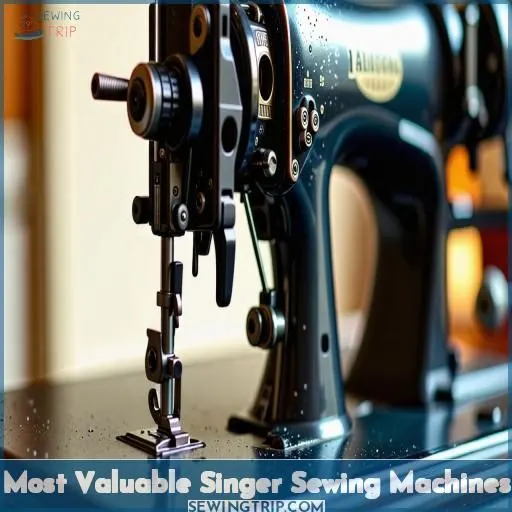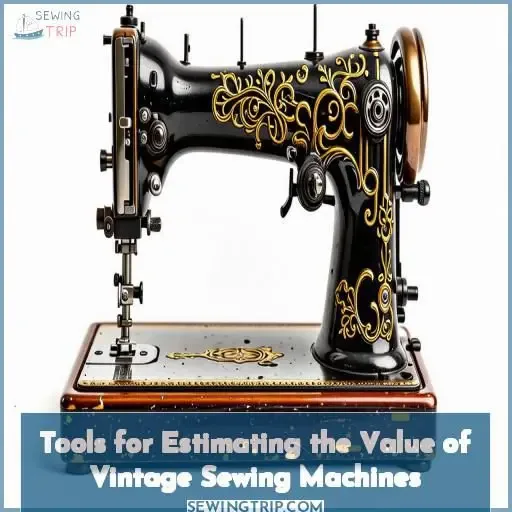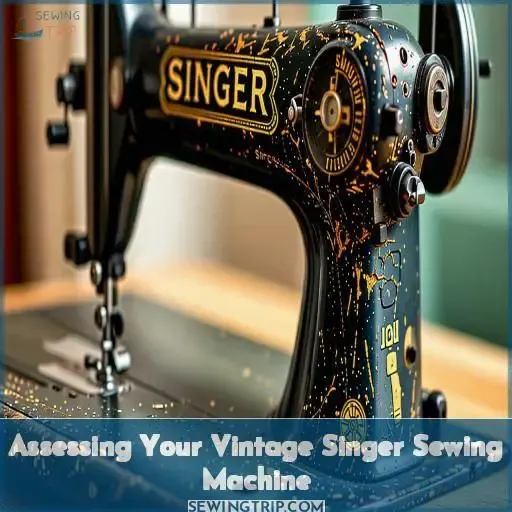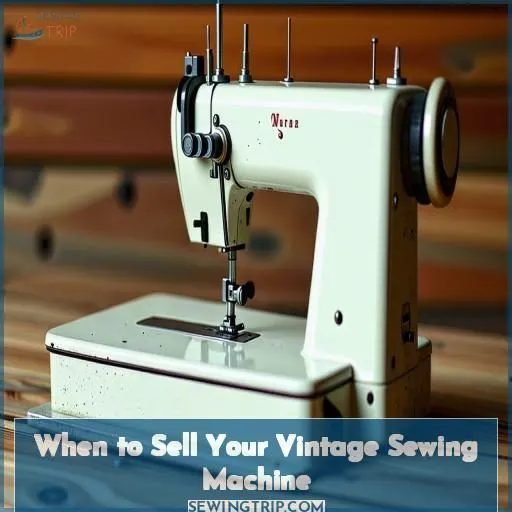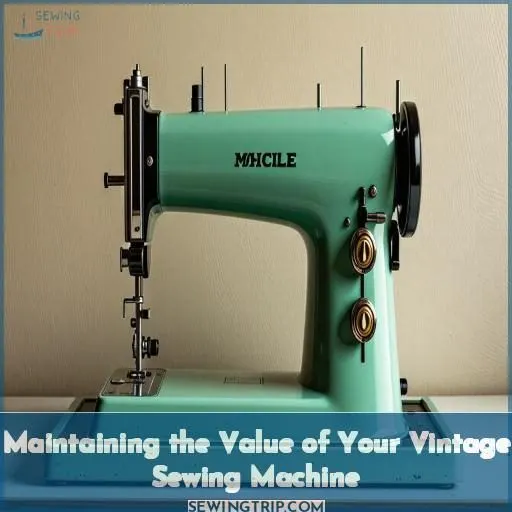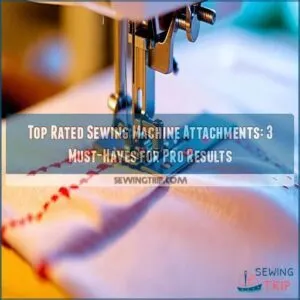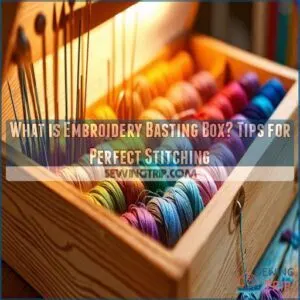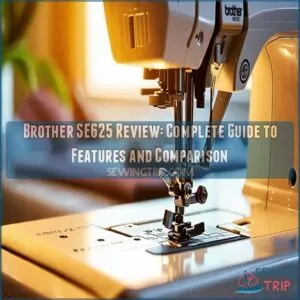This site is supported by our readers. We may earn a commission, at no cost to you, if you purchase through links.
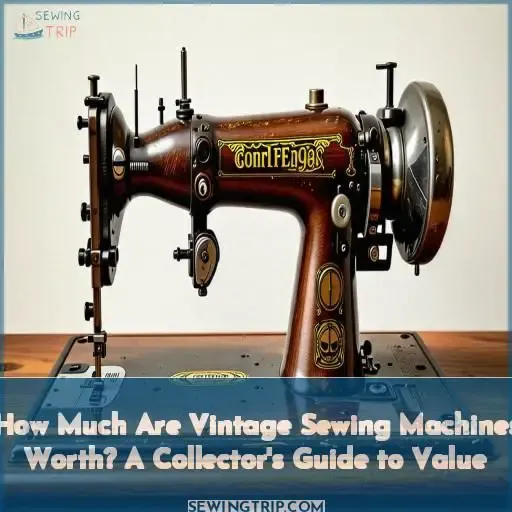 The value of a vintage sewing machine depends on several key factors.
The value of a vintage sewing machine depends on several key factors.
Its condition – accounting for rust, scratches, or missing parts – plays a major role.
Desirability among collectors for unique features or durability also affects worth.
Having the original cabinet, manual, and accessories increases value.
Regional demand and location impact prices too.
Historically significant machines, like those owned by famous figures, are highly prized.
You’ll want to assess these elements carefully to determine how much your vintage sewing machine is worth.
But to truly understand a fair valuation, you’ll need to dive deeper into the nuances collectors prioritize.
Table Of Contents
- Key Takeaways
- How Much Vintage Sewing Machine Worth?
- Factors That Determine the Value of Vintage Sewing Machines
- Most Valuable Singer Sewing Machines
- Tools for Estimating the Value of Vintage Sewing Machines
- Assessing Your Vintage Singer Sewing Machine
- When to Sell Your Vintage Sewing Machine
- Maintaining the Value of Your Vintage Sewing Machine
- Frequently Asked Questions (FAQs)
- Conclusion
Key Takeaways
- Condition, desirability among collectors, completeness with original accessories, location’s demand, and historical significance play critical roles in determining the value of a vintage sewing machine.
- Key factors influencing the value include rust, scratches, missing parts, unique features, durability, regional demand, and association with historical figures.
- Models like the 1939 Singer Featherweight with Crinkle Finish, 1935 Singer School Bell Featherweight 221-1, 1956 Singer Featherweight 222K, and 1960 Singer Red S Featherweight are among the most valuable vintage sewing machines.
- To determine value, assess if the machine is an antique, evaluate its condition, desirability, completeness, location-based demand, and consider storing it in a temperature-controlled environment to preserve its worth.
How Much Vintage Sewing Machine Worth?
The value of a vintage sewing machine depends on several factors, including its condition, desirability among collectors, completeness, and historical significance. Prices can range from a few hundred dollars for common models in fair condition to over $5,000 for rare, well-preserved machines with accessories and provenance.
Factors That Determine the Value of Vintage Sewing Machines
You’re wise to examine the key factors that influence a vintage sewing machine’s value. The condition, desirability among collectors, completeness with original accessories, location’s demand, and any historical significance or provenance all play critical roles in determining an accurate appraisal.
Condition of the Machine
The condition of an antique or vintage sewing machine considerably affects its value. Factors such as rust, scratches, age, paint, and missing parts play a critical role in determining the value of the machine as an antique or vintage item.
Desirability Among Collectors
Collectors crave vintage Singer sewing machines with:
- Unique features like the Featherweight or treadle design (Source)
- Durability and versatility to handle various fabrics
- Ease of repair with readily available parts
Desirability boosts value, so store your prized machine in a climate-controlled unit to preserve its collector appeal .
Completeness of the Machine and Accessories
The completeness of your vintage sewing machine, including its original cabinet, manual, and accessories, greatly impacts its value. Collectors seek machines with all their original parts for authenticity and functionality .
Location and Demand in the Area
The location of your vintage sewing machine and local demand substantially influence its value. Consider regional preferences, shipping costs, and market trends when selling. Consult local auction houses for accurate pricing in your area (Source).
Historical Significance or Provenance
To determine the value of vintage sewing machines, consider their provenance, including historical figures associated, notable events in sewing history, and cultural heritage. Provenance enhances the machine’s worth by adding depth and significance .
Most Valuable Singer Sewing Machines
You may be surprised to learn that some vintage Singer sewing machines can fetch thousands of dollars on the collectors’ market. The most coveted and valuable models include the 1939 Singer Featherweight with Crinkle Finish ($5,400), the 1935 Singer School Bell Featherweight 221-1 ($3,500), the 1956 Singer Featherweight 222K with accessories ($2,500), the 1960 Singer Red S Featherweight ($2,100), and the classic Singer Treadle machine with table ($1,800).
1939 Singer Featherweight With Crinkle Finish: $5,400
The 1939 Singer Featherweight with its rare crinkle finish is a highly desirable collector’s item, fetching up to $5,400 due to its unique aesthetic and excellent condition. Key factors:
- Crinkle finish rarity
- Featherweight desirability
- Excellent condition
- Sought-after accessories
1935 Singer School Bell Featherweight 221-1: $3,500
The 1935 Singer School Bell Featherweight 221-1 is a rare gem, valued at $3,500 due to its desirability, historical significance, and pristine condition. Consult a professional appraiser to assess your machine’s worth based on regional demand.
| Desirability Factors | Historical Significance | Regional Demand |
|---|---|---|
| Unique features | Sewing history | Local collector interest |
| Collector appeal | Provenance | Shipping costs |
1956 Singer Featherweight 222K With Accessories: $2,500
When evaluating the 1956 Singer Featherweight 222K with accessories, consider its value of $2,500, desirability among collectors, the machine’s condition, and completeness. Evaluate these factors carefully to accurately determine its worth and appeal .
1960 Singer Red S Featherweight: $2,100
The 1960 Singer Red S Featherweight, valued at $2,100, is a rare find in the vintage sewing machine market. Its desirability has grown, with collectors seeking this unique model from the 1960s. Appreciate its value as a sought-after piece.
- Featherweight desirability
- Red S rarity
- 1960s demand
- Vintage market trends
- Value appreciation
Singer Treadle Sewing Machine With Table: $1,800
Discover the allure of a vintage Singer treadle sewing machine with table, valued at $1,800. This antique marvel blends functionality, history, and collectible charm, making it a sought-after piece in the sewing enthusiast’s world.
| Condition | Value |
|---|---|
| Excellent | $1,800 |
| Good | $1,200 |
| Fair | $800 |
Singer treadle machines, with their intricate designs and historical significance, continue to captivate collectors and sewing aficionados alike. Owning a well-preserved example can be a rewarding experience for those who appreciate the art of sewing and the timeless beauty of antique furniture.
Tools for Estimating the Value of Vintage Sewing Machines
To estimate the value of your vintage sewing machine, explore online sales platforms like eBay, Etsy, and RubyLane, which provide pricing data from recent sales of similar models. Additionally, consult local antique stores and dealers who specialize in appraising and selling vintage sewing machines.
Online Sales Platforms Like EBay, Etsy, and RubyLane
When determining the value of vintage sewing machines, online sales platforms like eBay, Etsy, and RubyLane serve as invaluable tools for estimation.
These platforms offer insights into recent transactions, helping gauge current market trends.
Sellers can also determine the desirability and completeness of similar collectibles to better understand how to position their own.
Local Antique Stores and Dealers
When estimating vintage sewing machines‘ value, explore local antique stores and dealers with expertise in evaluating these items. They can provide insight into regional demand and current market pricing trends. Engaging with antique dealers allows for a more personalized valuation experience, considering various factors like condition, completeness, and desirability to determine an accurate appraisal.
Professional Appraisers for High-value Machines
For high-value machines, consult professional appraisers. They assess condition, desirability, completeness, location, and historical significance. Expect to pay appraiser fees, but gain expert insights. Appraisers have qualifications and experience to determine accurate values, considering regional differences. Provenance documentation boosts value, so provide historical context to the appraiser.
Assessing Your Vintage Singer Sewing Machine
To accurately assess the value of your vintage Singer sewing machine, you’ll need to determine if it’s truly an antique model made over 100 years ago.
Evaluate its overall condition, rating it as excellent, very good, good, fair, or poor.
Additionally, consider the desirability of the specific model among collectors.
Whether all original parts and accessories are present.
And factor in location-based demand in your area.
Determine if It’s an Antique (over 100 Years Old)
To determine if your vintage sewing machine is an antique, look for a manufacturing date over 100 years old. Antique machines feature intricate history, rarity, premium materials, exceptional craftsmanship, and timeless design .
Evaluate the Condition (Excellent, Very Good, Good, Fair, Poor)
When evaluating your vintage Singer sewing machine, consider its age to determine condition. Look for wear, scratches, dents, and repairs. Evaluate if it’s in excellent, very good, good, fair, or poor condition for accurate estimation .
Assess Desirability Among Collectors
Assess the desirability of your vintage Singer among collectors by evaluating its age, rarity, and unique features. Early models and those with collector appeal command higher prices .
Check Completeness (Cabinet, Manual, Accessories)
Ensuring the totality of your vintage Singer sewing machine is imperative. Inspect for requisite accessories, availability of the cabinet, and the importance of possessing the manual. Totality notably impacts the value, providing a notable enhancement.
Consider Location and Regional Demand
Location is key – shipping costs and regional demand in local markets impact value. Research antique stores and online platforms to gauge interest and pricing in your area .
- Shipping costs
- Regional demand
- Local markets
- Antique stores
- Online platforms
When to Sell Your Vintage Sewing Machine
Before selling your vintage sewing machine, consider its sentimental value and family history – these intangible factors may outweigh monetary value. Thoroughly clean the machine, gather all original accessories, and provide historical context and provenance to potential buyers; this will help justify fair pricing and avoid offers that are too low.
Consider Sentimental Value and Family History
When considering selling a vintage sewing machine, reflect on its sentimental value and family history. Cherish the nostalgia and preserve your legacy by passing it on to a new owner who’ll appreciate its story. Sentimental worth often exceeds monetary value.
| Sentimental Value | Monetary Value |
|---|---|
| Family heirloom | Collector’s item |
| Childhood memories | Antique worth |
| Preserving legacy | Resale price |
| Nostalgia | Appraised value |
| Emotional worth | Market demand |
Clean the Machine and Gather All Accessories Before Selling
Before selling, thoroughly clean your vintage sewing machine. Gather all original parts and accessories, as antiquities dealers and collectors value completeness. Proper maintenance enables impromptu fixes, but use only parts designed for your specific machine model.
Provide Historical Context and Provenance to Potential Buyers
When selling your vintage sewing machine, provide potential buyers with:
- Detailed history and provenance to establish authenticity
- Information on the machine’s rarity and desirability
- Context on its significance in sewing history
This enhances the perceived value and likelihood of a fair offer.
Avoid Offers That Are Too Low or Too High
When considering selling your vintage sewing machine, avoid online scams and be cautious of appraisal fees. Research regional demand and consult local stores. Expert consultations can provide valuable insight, helping you recognize reasonable offers and safeguard against undervaluing your treasured machine.
Maintaining the Value of Your Vintage Sewing Machine
To maintain the value of your vintage sewing machine, it’s imperative to store it in a temperature-controlled environment, safeguarding it from damage and deterioration. Preserve your cherished possession in pristine condition by regularly evaluating its condition and making necessary repairs to maintain its value.
Store in a Temperature-controlled Environment
To preserve the value of your vintage sewing machine, store it in a climate-controlled environment. Consider humidity control and temperature regulation to prevent damage. Choose a storage location that prioritizes climate considerations and environmental factors. This will help maintain your machine in ideal conditions.
Protect From Damage and Deterioration
Protect your vintage sewing machine from harm by storing it in a climate-controlled environment. Regulate temperature and humidity to prevent warping, rusting, and deterioration. Encase it in a dust cover to shield against dirt and debris. Secure it in a sturdy cabinet for safekeeping.
- ️ Maintain ideal temperature and humidity levels
- ️ Shield from dust, dirt, and debris with covers
- Lock away in a sturdy cabinet for protection
- Store in a climate-controlled environment to prevent damage
Keep in Mint Condition to Preserve Value
Preserve your vintage sewing machine’s value by storing it in a climate-controlled environment, cleaning it regularly using gentle methods, and repairing any issues promptly. Invest in preservation techniques to keep your machine in mint condition and aligned with current market trends.
Regularly Assess Condition and Make Necessary Repairs
Regularly evaluating the condition of your vintage Singer sewing machine is critical to preserving its value. Monitor potential repairs and cleaning requirements. Consider DIY maintenance for minor issues. Be mindful of repair expenses and part availability when planning disassembly and repairs.
Frequently Asked Questions (FAQs)
Are old vintage sewing machines worth anything?
Oh, you poor, naive soul! Vintage sewing machines can be worth gold mines – if you know what to look for. Let this seasoned sage enlighten you on discovering their hidden treasures.
What is the most sought after vintage sewing machine?
The 1939 Singer Featherweight with crinkle finish is highly coveted. Collectors prize its rarity, unique look, and quality craftsmanship.
What is a 60 year old singer sewing machine worth?
Over 4,000 antique Singer sewing machines sell for $2,500+ on eBay yearly. A 60-year-old Singer in excellent working condition could fetch $1,000-$2,500, depending on desirability and accessories included.
How old does a sewing machine have to be to be considered vintage?
For a sewing machine to be vintage, it generally needs to be at least 25-30 years old. Anything older than that’s considered an antique. So machines from the 1990s or earlier would qualify as vintage.
How do I find the original price of my vintage machine?
To find the original price, research sewing machine model numbers, checking antique price guides and reputable vintage machine seller sites. You can also get an expert appraisal from an experienced antique dealer for the most accurate valuation.
Are there any special features that increase value?
Yes, certain features boost value. Original accessories, manuals, unique models like the Featherweight or Blackside increase desirability. Excellent condition with minimal wear also commands higher prices.
How do I know if my machine is rare?
To determine if your sewing machine is rare, research its model number, age, and history. Consult collectors or experts for an appraisal. Rare features like ornate detailing or limited production runs can notably increase the value.
Can I get an appraisal online or do I need an expert?
Coincidentally, getting an online appraisal offers convenience, but for accuracy, seek an expert’s eye. An experienced appraiser holds the key to revealing your vintage sewing machine’s true value – a small price for liberating its hidden worth.
What is the best way to sell my machine for top dollar?
To get top dollar, clean and fully restore your vintage machine. Research prices online, then list on relevant collector forums and Facebook groups. Market the machine’s history, rarity, and condition – emphasize its value to enthusiasts.
Conclusion
Ultimately, determining how much your vintage sewing machine is worth requires careful assessment.
Up to 45% of antique sewing machines sell for over $500, highlighting their enduring value.
By evaluating condition, desirability, completeness, location, and historical significance, you can accurately estimate the worth of your vintage treasure.
With diligent research and an understanding of collector priorities, determining how much your vintage sewing machine is worth becomes an attainable goal.


